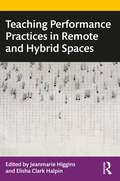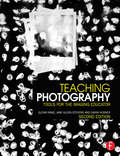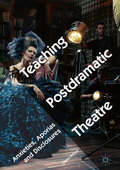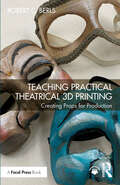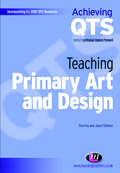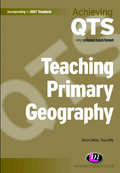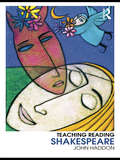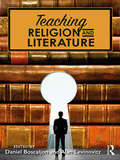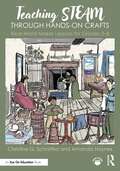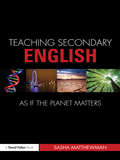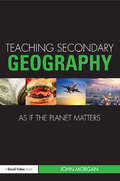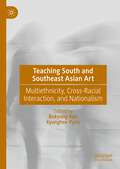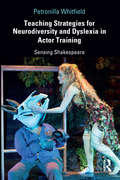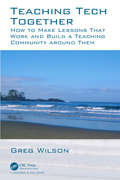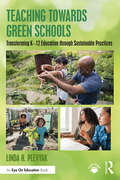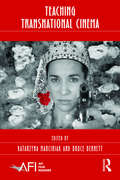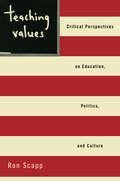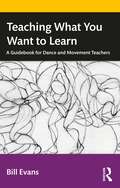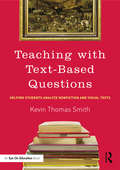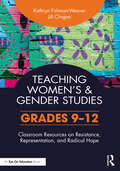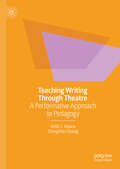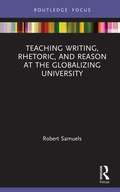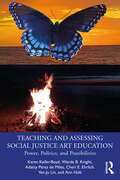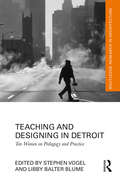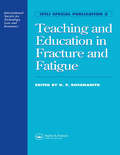- Table View
- List View
Teaching Performance Practices in Remote and Hybrid Spaces
by Jeanmarie HigginsThis collection of insightful essays gives teachers’ perspectives on the role of space and presence in teaching performance. It explores how the demand for remote teaching can be met while at the same time successfully educating and working compassionately in this most ‘live’ of disciplines. Teaching Performance Practices in Remote and Hybrid Spaces reframes prevailing ideas about pedagogy in dance, theatre, and somatics and applies them to teaching in face-to-face, hybrid, and remote situations. Case studies from instructors and professors provide essential, practical suggestions for remotely teaching a vast range of studio courses, including tap dance, theatre design, movement, script analysis, and acting, rendering this book an invaluable resource. The challenges that teachers are facing in the early twenty-first century are addressed throughout, helping readers to navigate these unprecedented circumstances whilst delivering lessons, guiding workshops, rehearsing, or even staging performances. This book is invaluable for dance and theatre teachers or leaders who work in the performing arts and related disciplines. It is also ideal for any professionals who need research-based solutions for teaching performance online.
Teaching Photography: Tools for the Imaging Educator (Photography Educators Series)
by Glenn Rand Garin Horner Jane Alden StevensThe photographic community is rife with talented and creative practitioners and artists. But making great photographs does not always translate into an ability to teach effectively. This new edition of Teaching Photography approaches photographic education from a point of view that stresses the how and why of the education. It includes the resources that will inspire new and seasoned teachers to help students expand their technical and aesthetic abilities and techniques, as well as their visual literacy and the way photography fits into the wider world. Fully updated to include the online/hybrid classroom environment, collaborative learning, rubrics, and using digital technology, plus techniques for inspiring conversations and critiques.
Teaching Postdramatic Theatre: Anxieties, Aporias and Disclosures
by Glenn D’CruzThis book explores the concept and vocabulary of postdramatic theatre from a pedagogical perspective. It identifies some of the major anxieties and paradoxes generated by teaching postdramatic theatre through practice, with reference to the aesthetic, cultural and institutional pressures that shape teaching practices. It also presents a series of case studies that identify the pedagogical fault lines that expose the power-relations inherent in teaching (with a focus on the higher education sector as opposed to actor training institutions). It uses auto-ethnography, performance analysis and critical theory to assist university teachers involved in directing theatre productions to deepen their understanding of the concept of postdramatic theatre.
Teaching Practical Theatrical 3D Printing: Creating Props for Production
by Robert C. BerlsTeaching Practical Theatrical 3D Printing: Creating Props for Production is a cohesive and practical guide for instructors teaching 3D printing techniques in stagecraft, costume and props courses.Written for the instructor, this book uses non-technical language to explain 3D printers, their workflows and products. Coverage includes the ins and outs of multiple filaments, pros and cons of different types of printers, shop or laboratory setup and safety concerns. The book features lesson plans, rubrics and class-tested sample student projects from design to finished product that highlight learning objectives and methodologies, as well as software and hardware usage explanations and common problems that can occur within design and printing. Step-by-step instructions are included for many types of projects, including fake noses, candlestick phones, buttons, 3D scans, historical recreations and linear actuators. The book also contains examples of poor, average and excellent work with grading explanations and guidance on how to help the student move to the next level with their projects. Chapter objectives, chapter summaries, checklists and reflection points facilitate an instructor in gaining confidence with 3D printers and incorporating their use in the classroom.Teaching Practical Theatrical 3D Printing is an excellent resource for instructors of Props and Costume Design and Construction courses that are interested in using state of the art tools and technology for theatre production.Fully editable files for every object featured in the book are available at www.routledge.com/9781032453279, allowing readers to jump-start their projects and giving them the flexibility to change and redesign the items to best fit their needs.
Teaching Primary Art and Design (Achieving QTS Series)
by Paul Key Jayne StillmanThis book introduces trainees and newly qualified primary teachers to the teaching of art and design in primary schools. It helps students gain an appreciation of what constitutes good practice in primary art and design and how they can go about achieving it. To meet the different needs of students, the book identifies varying levels of experience, creativity and confidence, and offers suggestions for applying these levels to the classroom. The book covers key areas of the art and design curriculum for Early Years Foundation Stage, Key Stage 1 and Key Stage 2, considering both their discrete and developmental characteristics.
Teaching Primary Geography (Achieving QTS Series)
by Simon Catling Tessa WillyWritten with reference to the 2007 Professional Standards for the Award of QTS and initiatives such as the Primary National Strategy, each chapter offers practical guidance on topics such as planning, assessment and the creation of resources. It provides summaries of key topics in primary geography, including the study of places, environmental sustainability, learning beyond the classroom, global issues, citizenship and cross-curricular approaches to promote children’s subject knowledge, well-being and learning within primary geography. With research summaries, practical and reflective tasks, and classroom examples, this book helps trainees and NQTs teach primary geography confidently and creatively throughout the primary school.
Teaching Reading Shakespeare
by John HaddonTeaching Reading Shakespeare is warmly and clearly communicated, and gives ownership of ideas and activities to teachers by open and explicit discussion. John Haddon creates a strong sense of community with teachers, raising many significant and difficult issues, and performing a vital and timely service in doing so. - Simon Thomson, Globe Education, Shakespeare’s Globe John Haddon offers creative, systematic and challenging approaches which don’t bypass the text but engage children with it. He analyses difficulty rather than ignoring it, marrying his own academic understanding with real sensitivity to the pupils’ reactions, and providing practical solutions. - Trevor Wright, Senior Lecturer in Secondary English, University of Worcester, and author of 'How to be a Brilliant English Teacher', also by Routledge. Teaching Reading Shakespeare is for all training and practising secondary teachers who want to help their classes overcome the very real difficulties they experience when they have to ‘do’ Shakespeare. Providing a practical and critical discussion of the ways in which Shakespeare’s plays present problems to the young reader, the book considers how these difficulties might be overcome. It provides guidance on: confronting language difficulties, including ‘old words’, meaning, grammar, rhetoric and allusion; reading the plays as scripts for performance at Key Stage 3 and beyond; using conversation analysis in helping to read and teach Shakespeare; reading the plays in contextual, interpretive and linguistic frameworks required by examinations at GCSE and A Level. At once practical and principled, analytical and anecdotal, drawing on a wide range of critical reading and many examples of classroom encounters between Shakespeare and young readers, Teaching Reading Shakespeare encourages teachers to develop a more informed, reflective and exploratory approach to Shakespeare in schools.
Teaching Religion and Literature
by Daniel Boscaljon Alan LevinovitzTeaching Religion and Literature provides a practical engagement with the pedagogical possibilities of teaching religion courses using literature, teaching literature classes using religion, and teaching Religion and Literature as a discipline. Featuring chapters written by award winning teachers from a variety of institutional settings, the book gives anyone interested in providing interdisciplinary education a set of questions, resources, and tools that will deepen a classroom’s engagement with the field. Chapters are grounded in specific texts and religious questions but are oriented toward engaging general pedagogical issues that allow each chapter to improve any instructor’s engagement with interdisciplinary education. The book offers resources to instructors new to teaching Religion and Literature and provides definitions of what the field means from senior scholars in the field. Featuring a wide range of religious traditions, genres, and approaches, the book also provides an innovative glimpse at emerging possibilities for the sub-discipline.
Teaching STEAM Through Hands-On Crafts: Real-World Maker Lessons for Grades 3-8
by Amanda Haynes Christine G. SchnittkaHelp your students connect historic technologies with today’s STEAM concepts through the lens of crafting! This book, written by a science education professor and a middle school STEM teacher, provides guidance for turning classic crafts into transdisciplinary STEAM lessons for grades 3–8. Ready-to-use lessons outline the history, science, mathematics, and engineering embedded within ten hands-on crafts from around the world. Each chapter outlines the history of a craft, its social impact, and the mathematics, engineering, and scientific concepts and skills embedded in the craft. Content standards from art, history, English language arts, technology, mathematics, and science are embedded within each unit. Lessons are supplemented with ready-to-photocopy handouts, guiding questions, and logistical support such as shopping lists and safety procedures. Activities have all been classroom-tested to ensure appropriate leveling and applicability across STEAM disciplines. Ideal for any STEM or STEAM classroom across upper elementary and middle schools, this book helps make STEM concepts meaningful and tangible for your students. Rather than just reading about science, technology, mathematics, or engineering, students will become makers and engage in STEAM directly, just as original crafters have done for centuries.Additional instructional materials are available at: https://steamcrafts.weebly.com/
Teaching Secondary English as if the Planet Matters
by Sasha Matthewman‘This is an important book for all concerned with the teaching and learning of English, exploring new and hugely significant areas in a scholarly, thought-provoking and eminently practical way.’ – David Stevens, University of Durham, UK Drawing together ideas from a range of disciplines in the study of texts which explore nature, the built environment and issues of climate change and environmental stress, this book shows how English is well placed to develop the cultural, aesthetic and emotional response to environmental themes – both as part of everyday practice and within wider curriculum innovations. Features include: critical reflection on the teaching of secondary English connections with the academic study of ecocriticism and/or key environmental issues suggested teaching activities and/or reflections from classroom practice sources of further reading and information. The true worth of a school subject is revealed in how far it can account for and respond to the major issues of the time. This timely textbook breaks new ground in showing how English teachers can have a pivotal role in responding to the environmental crisis.
Teaching Secondary Geography as if the Planet Matters (Teaching... as if the Planet Matters)
by John Morgan'Teaching Geography as if the Planet Matters provides a timely outline of powerful knowledge and arguments that will be needed to counter a strengthening of current curriculum orthodoxies. Not until school geography undergoes the revolution that this book outlines can it honestly claim to be contributing to more sustainable futures.' - John Huckle, Visiting Fellow at the University of York and was formerly Principal Lecturer in Educaton at De Montfort University. We are surrounded by images and warnings of impending environmental disaster. Climate change, famine, population growth and urban crisis coupled with more recent financial chaos all threaten our sense of what it will be like to live in the future. This thought-provoking text looks at how Geography teachers can develop approaches to curriculum and learning which help students understand the nature of the contemporary world. It sets out a model for teaching and learning that allows teachers to examine existing approaches to teaching and draw upon the insights of geography as a discipline to deepen students’ understanding of urban futures, climate change, ‘geographies of food’ and the ‘geographies of the credit crunch’. Features include: examples of suggested teaching activities questions and activities for further study detailed case studies sources of further reading and information The true worth of a school subject is revealed in how far it can account for and respond to the major issues of the time. The issue of the environment cuts across subject boundaries and requires an interdisciplinary response. Geography teachers are part of that response and they have a crucial role in helping students to respond to environmental issues and representations.
Teaching South and Southeast Asian Art: Multiethnicity, Cross-Racial Interaction, and Nationalism
by Kyunghee Pyun Bokyung KimThis volume challenges existing notions of what is “Indian,” “Southeast Asian,” and/or “South Asian” art to help educators present a more contextualized understanding of art in a globalized world. In doing so, it (re)examines how South or Southeast Asian art is being made, exhibited, circulated and experienced in new ways in the United States or in regions under its cultural hegemony. The essays presented in this book examine both historical and contemporary transformations or lived experiences of monuments and regional styles (sites) from South or Southeast Asian art in art making, subsequent usage, and exhibition-making under the rubric of “Indian,” “South Asian,” “or “Southeast Asian” Art.
Teaching Strategies for Neurodiversity and Dyslexia in Actor Training: Sensing Shakespeare
by Petronilla WhitfieldTeaching Strategies for Neurodiversity and Dyslexia in Actor Training addresses some of the challenges met by acting students with dyslexia and highlights the abilities demonstrated by individuals with specific learning differences in actor training. The book offers six tested teaching strategies, created from practical and theoretical research investigations with dyslexic acting students, using the methodologies of case study and action research. Utilizing Shakespeare’s text as a laboratory of practice and drawing directly from the voices and practical work of the dyslexic students themselves, the book explores: the stress caused by dyslexia and how the teacher might ameliorate it through changes in their practice the theories and discourse surrounding the label of dyslexia the visual, kinaesthetic, and multisensory processing preferences demonstrated by some acting students assessed as dyslexic acting approaches for engaging with Shakespeare’s language, enabling those with dyslexia to develop their authentic voice and abilities a grounding of the words and the meaning of the text through embodied cognition, spatial awareness, and epistemic tools Stanislavski’s method of units and actions and how it can benefit and obstruct the student with dyslexia when working on Shakespeare Interpretive Mnemonics as a memory support and hermeneutic process, and the use of color and drawing towards an autonomy in live performance This book is a valuable resource for voice and actor training, professional performance, and for those who are curious about emancipatory methods that support difference through humanistic teaching philosophies.
Teaching Tech Together: How to Make Your Lessons Work and Build a Teaching Community around Them
by Greg WilsonHundreds of grassroots groups have sprung up around the world to teach programming, web design, robotics, and other skills outside traditional classrooms. These groups exist so that people don't have to learn these things on their own, but ironically, their founders and instructors are often teaching themselves how to teach. There's a better way. This book presents evidence-based practices that will help you create and deliver lessons that work and build a teaching community around them. Topics include the differences between different kinds of learners, diagnosing and correcting misunderstandings, teaching as a performance art, what motivates and demotivates adult learners, how to be a good ally, fostering a healthy community, getting the word out, and building alliances with like-minded groups. The book includes over a hundred exercises that can be done individually or in groups, over 350 references, and a glossary to help you navigate educational jargon.
Teaching Towards Green Schools: Transforming K–12 Education through Sustainable Practices
by Linda H. PlevyakThis engaging and timely book showcases practical ways that PreK–12 teachers and school leaders can create and implement sustainability-focused projects and practices in their classrooms and schools, helping promote a healthy, sustainable environment and curriculum for students and leading the way towards becoming a green school. Sharing real-world case studies and detailed walk-throughs of sustainable schools in action – from Madison, Alabama, to Bali, Indonesia – author Linda H. Plevyak lays out the benefits, principles and practices of creating a sustainable school from beginner classroom projects like creating a garden, recycling and composting to more complex and school-wide initiatives like energy audits, creating an environmental management system, engaging with policy and building and leveraging community partnerships. Plevyak highlights sustainable practices that can be developed with little to no budget and focuses on those that support the development of critical thinking skills, promote project-based learning and consider the environment as a learning tool, incorporating sustainability as a natural progression of the learning process. The book outlines extensive resources teachers and schools can use to embed sustainability in their programs and curriculum, offering teachers, school leaders and policy makers the tools they need to provide this generation of students with the knowledge and skills to create a more sustainable world.
Teaching Transnational Cinema: Politics and Pedagogy (AFI Film Readers)
by Bruce Bennett Katarzyna MarciniakThis collection of essays offers a pioneering analysis of the political and conceptual complexities of teaching transnational cinema in university classrooms around the world. In their exploration of a wide range of films from different national and regional contexts, contributors reflect on the practical and pedagogical challenges of teaching about immigrant identities, transnational encounters, foreignness, cosmopolitanism and citizenship, terrorism, border politics, legality and race. Probing the value of cinema in interdisciplinary academic study and the changing strategies and philosophies of teaching in the university, this volume positions itself at the cutting edge of transnational film studies.
Teaching Values: Critical Perspectives on Education, Politics, and Culture
by Ron ScappIn Teaching Values, Ron Scapp wrests the discussion of values and values-based education away from traditionalists who have long dominated educational debates. While challenging the Right's domination of the discussion of values education, Scapp examines some issues not typically raised by educators and critics on the Left, including the positive role of citizenship and national identity in U.S. education and culture.
Teaching What You Want to Learn: A Guidebook for Dance and Movement Teachers
by Bill EvansTeaching What You Want to Learn distills the five decades that Bill Evans has spent immersed in teaching dance into an indispensable guide for today’s dance instructor. From devising specific pedagogical strategies and translating theory into action, to working with diverse bodies and embracing evolving value systems, Evans has considered every element of the teacher’s role and provided 94 essential essays about becoming a more effective and satisfied educator. As well as setting out his own particular training methods and somatic practice as one of the world's leading dance teachers, he explores the huge range of challenges and rewards that a teacher will encounter across their career. These explorations equip the reader not only to enable and empower their students but also to get the most out of their own work so they are learning as they teach. This is an essential book for anyone who wants to teach dance and movement, from professional and academic settings to amateur artists and trainee instructors.
Teaching With Text-Based Questions: Helping Students Analyze Nonfiction and Visual Texts
by Kevin Thomas SmithHelp your students navigate complex texts in history/social studies and English language arts! This book shows you how to use a key tool—text-based questions—to build students’ literacy and critical thinking skills and meet the Common Core State Standards. You’ll learn how to ask text-based questions about different types of nonfiction and visual texts, including primary and secondary sources, maps, charts, and paintings. You’ll also get ideas for teaching students to examine point of view, write analytical responses, compare texts, cite textual evidence, and pose their own high-level questions. The book is filled with examples that you can use immediately or modify as needed. Each chapter ends with a reflection section to help you adapt the ideas to your own classroom. What’s Inside: Helpful information on teaching different types of nonfiction texts, including literary nonfiction, informational texts, primary and secondary sources, and visual texts Ideas for locating primary sources Questions students should ask about every text Techniques for soliciting higher-order questions from students Ways to get students to think critically about the relationships between texts Strategies to help students integrate information from different types of sources, a skill that will help students respond to performance tasks on the PARCC and SBAC assessments and DBQs on AP exams Tips for teaching students to write good responses to text-based questions, including how to cite sources and incorporate point of view Ideas for using rubrics and peer grading to evaluate students’ responses Connections to the informational reading standards of the Common Core State Standards for English Language Arts for grades 3-12 and of the Common Core State Standards for Literacy in History/Social Studies, Science, and Technical Subjects
Teaching Women's and Gender Studies: Classroom Resources on Resistance, Representation, and Radical Hope (Grades 9-12)
by Kathryn Fishman-Weaver Jill ClinganIncorporate women’s and gender studies into your high school classroom using the powerful lesson plans in this book. The authors present seven units organized around four key concepts: Why WGST; Intersectionality; Motherland—History, Health, and Policy Change; and Artivism. With thought questions for activating prior knowledge, teaching notes, reflection questions, reproducibles, and strategies, these units are ready to integrate purposefully into your existing classroom practice. Across various subject areas and interdisciplinary courses, these lessons help to fill a critical gap in the curriculum. Through affirming, inclusive, and representative projects, this book offers actionable ways to encourage and support young people as they become changemakers for justice. This book is part of a series on teaching Women’s and Gender Studies in the K-12 classroom. We encourage readers to also check out the middle school edition.
Teaching Writing Through Theatre: A Performative Approach to Pedagogy
by Dongshin Chang Kelly I. AlianoThis volume presents an introspective study of writing pedagogy, explored through the lens of theatre and performance. The chapters explore assessment and issues related to student engagement, in both in-person and online learning spaces, and consider aspects such as class design, environment, activities, and curriculum. The authors draw on educational theory and inquiry-based pedagogy as well as their own experiences to lay out a comprehensive blueprint for teaching in a student centered classroom.
Teaching Writing, Rhetoric, and Reason at the Globalizing University (Routledge Research in Writing Studies)
by Robert SamuelsThis timely intervention into composition studies presents a case for the need to teach all students a shared system of communication and logic based on the modern globalizing ideals of universality, neutrality, and empiricism. Based on a series of close readings of contemporary writing by Stanley Fish, Asao Inoue, Doug Downs and Elizabeth Wardle, Richard Rorty, Slavoj Zizek, and Steven Pinker, this book critiques recent arguments that traditional approaches to teaching writing, grammar, and argumentation foster marginalization, oppression, and the restriction of student agency. Instead, it argues that the best way to educate and empower a diverse global student body is to promote a mode of academic discourse dedicated to the impartial judgment of empirical facts communicated in an open and clear manner. It provides a critical analysis of core topics in composition studies, including the teaching of grammar; notions of objectivity and neutrality; empiricism and pragmatism; identity politics; and postmodernism. Aimed at graduate students and junior instructors in rhetoric and composition, as well as more seasoned scholars and program administrators, this polemical book provides an accessible staging of key debates that all writing instructors must grapple with.
Teaching and Assessing Social Justice Art Education: Power, Politics, and Possibilities
by Ann Holt Karen Keifer-Boyd Wanda B. Knight Adetty Pérez de Miles Cheri E. Ehrlich Yen-Ju LinThis incisive and wholly practical book offers a hands-on guide to developing and assessing social justice art education for K–12 art educators by providing theoretically grounded, social justice art education assessment strategies. Recognizing the increased need to base the K–12 curriculum in social justice education, the authors ground the book in six social justice principles–conceptualized through art education–to help teachers assess and develop curriculum, design pedagogy, and foster social justice learning environments. From encouraging teachers to be upstanders to injustice to engaging in decolonial action, this book provides a thorough guide to facilitating and critiquing social justice art education and engaging in reflexive praxis as educators. Rich in examples and practical application, this book provides a clear pathway for art educators to connect social justice art education with real-life educational assessment expectations: 21st-century learning, literacy, social skills, teacher performance-based assessment, and National Core Art Standards, making this text an invaluable companion to art educators and facilitators alike
Teaching and Designing in Detroit: Ten Women on Pedagogy and Practice (Routledge Research in Architecture)
by Stephen Vogel Libby Balter BlumeThis book provides a compelling and insightful portrait of ten female architects, artists, and designers who explored unique approaches to teaching, practice, and research in the postindustrial city of Detroit. These women explored the phenomenon of a new “ecological urbanism” through their own work in art, architecture, design, planning, landscape architecture, and installation as well as the work of their students. Teaching and Designing in Detroit provides an eighteen-year snapshot of this work, how it affected the women’s practice, how they influenced student relationships to design and community development, and how their visions are now being carried out in Detroit. This book is organized into sections that group stories according to their focus on practice, pedagogy, and community engagement. Included in the book is a foreword by Leslie Kanes Weisman, the only female architecture professor at the University of Detroit Mercy in the 1970s, and an afterword by Sharon Egretta Sutton reflecting on how working and practicing in Detroit foreshadowed the future vision now being carried out in the rebounding city of Detroit. An intriguing read for students and professionals, this book will illustrate how these lessons learned can be applied by universities and communities in other postindustrial cities.
Teaching and Education in Fracture and Fatigue
by H. P. RossmanithThis proceedings contains the best contributions to the series of seminars held in Vienna (1992), Miskolc, Hungary (1993 and 1994) and Vienna (1995) and provides a valuable resource for those concerned with the teaching of fracture and fatigue. It presents a wide range of approaches relevant to course and curriculum development. It is aimed particu
